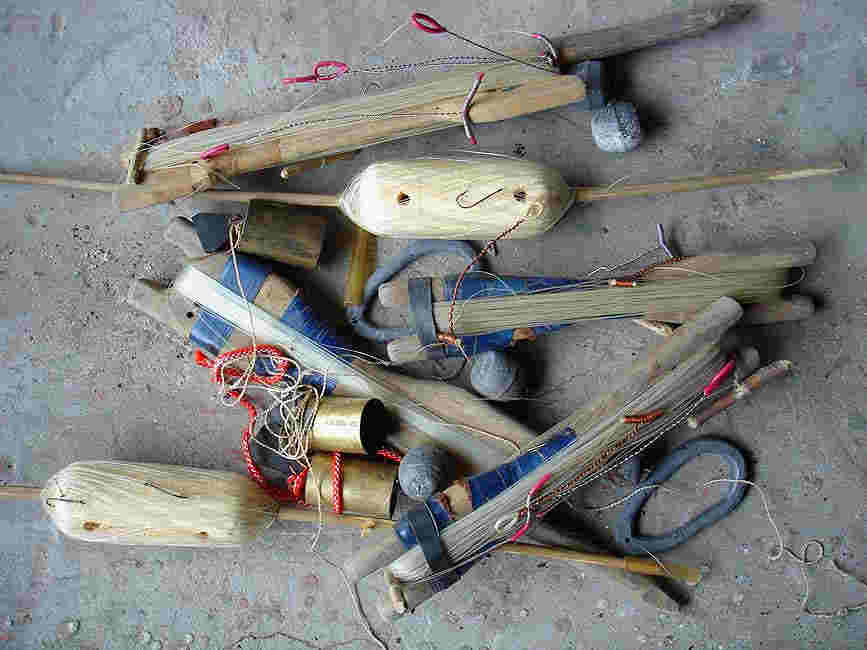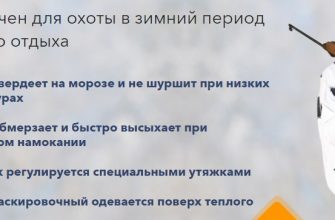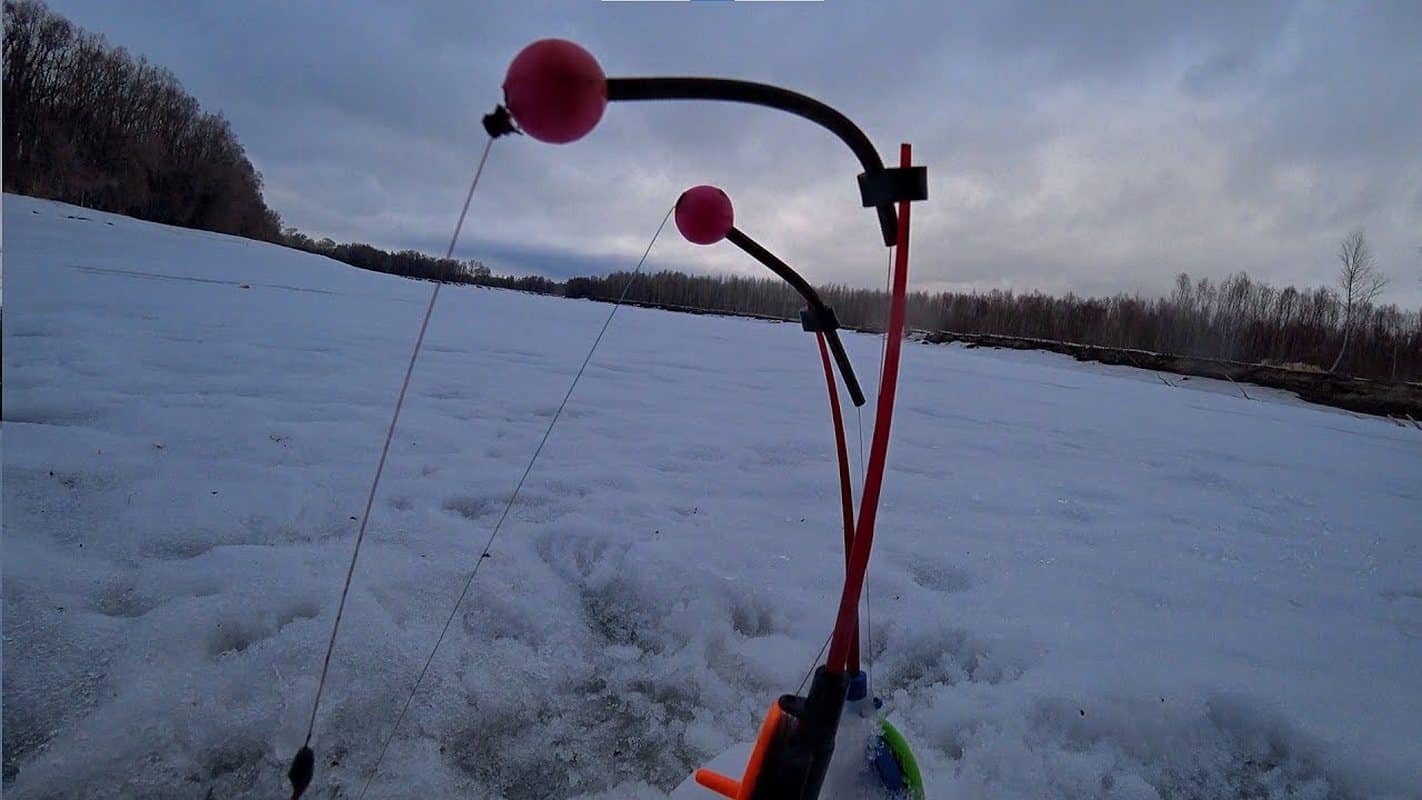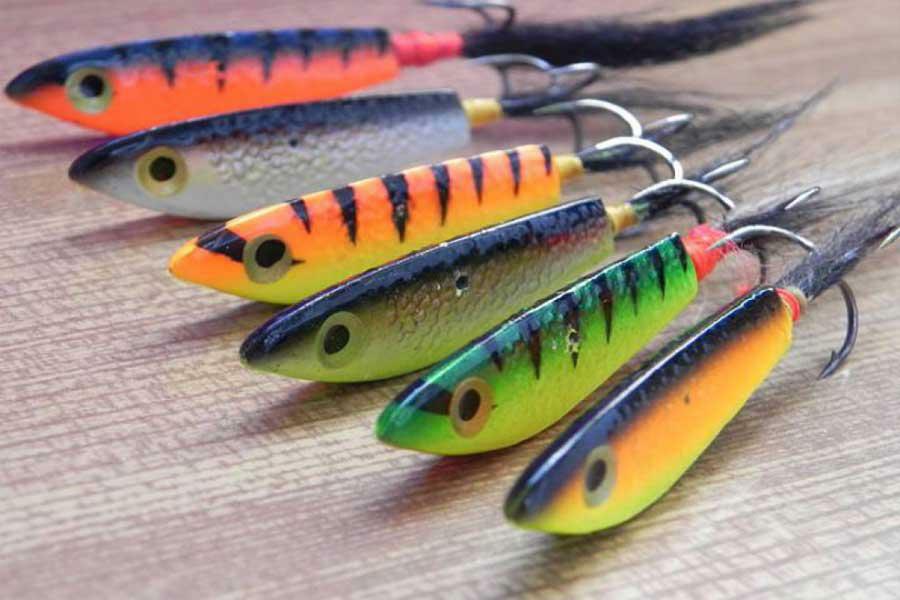Fishing tackle is being improved all the time. On the one hand, fishing companies are engaged in this. On the other hand, the anglers themselves from time to time come up with new rigs that are ideal for fishing in specific conditions. This is especially true for Russian fishing enthusiasts.
- What is winter donka
- When you need a winter donka on ice fishing
- Winter bottom construction – accessories
- Alarm clock
- Fishing line
- Nod
- Rigging
- Varieties of winter bottoms – installation and equipment options
- Cargo – standard donk for ice fishing
- Donka without a fishing rod
- Donka caster
- Winter feeder
- Tackle for pull-up fishing
- Donka descent
- Donka helicopter (wing) – bottom tackle for fishing in winter
- Donka rocker
- Winter donk for fishing in stagnant water
- How to assemble a winter donka with your own hands
- How to fish on a winter donkey: tactics, rules, secrets
- Catching different types of fish on a winter donkey
- How to catch roach on a winter donkey
- Bream for bottom tackle
- Carp
- Ide
- Whitefish fishing
- Burbot
- Perch
- Pike perch and bersh
- Pike
- Поделиться ссылкой:
What is winter donka
Winter donk is a tackle that, due to its design, makes it possible to fish on the current of any force. Despite its name, the winter bottom allows you to fish not only the bottom, but also the middle layers of water. In summer fishing, the analogs of the winter donkey are the “rolling” fishing of peaceful and predatory fish and, to some extent, the ” lead-off ” rig
for spinning. The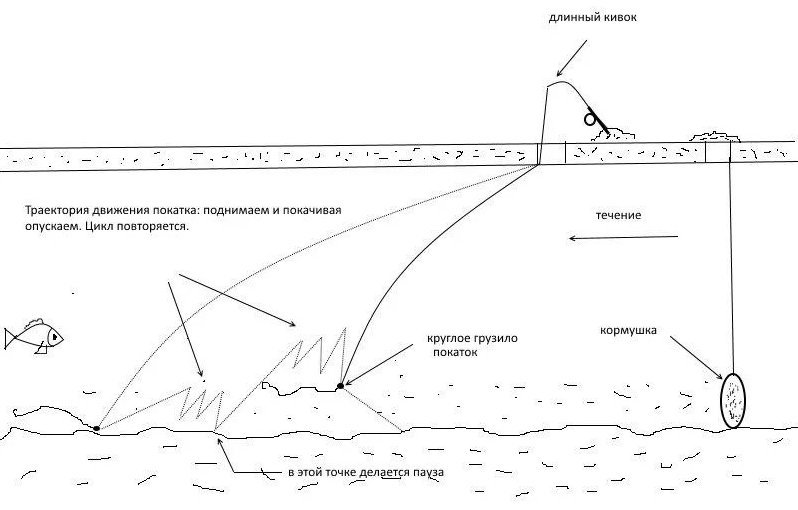
When you need a winter donka on ice fishing
The winter donk is best used when fishing in the current, especially when fishing in a lure place or with a feeder that replaces the lead. In uncomfortable weather conditions, fishing with a winter bottom makes fishing easier, since there is no need to constantly hold the rod in hand. With the help of a winter bottom, you can fish a significant area, being sure that the bait and the nozzle are in close proximity to each other.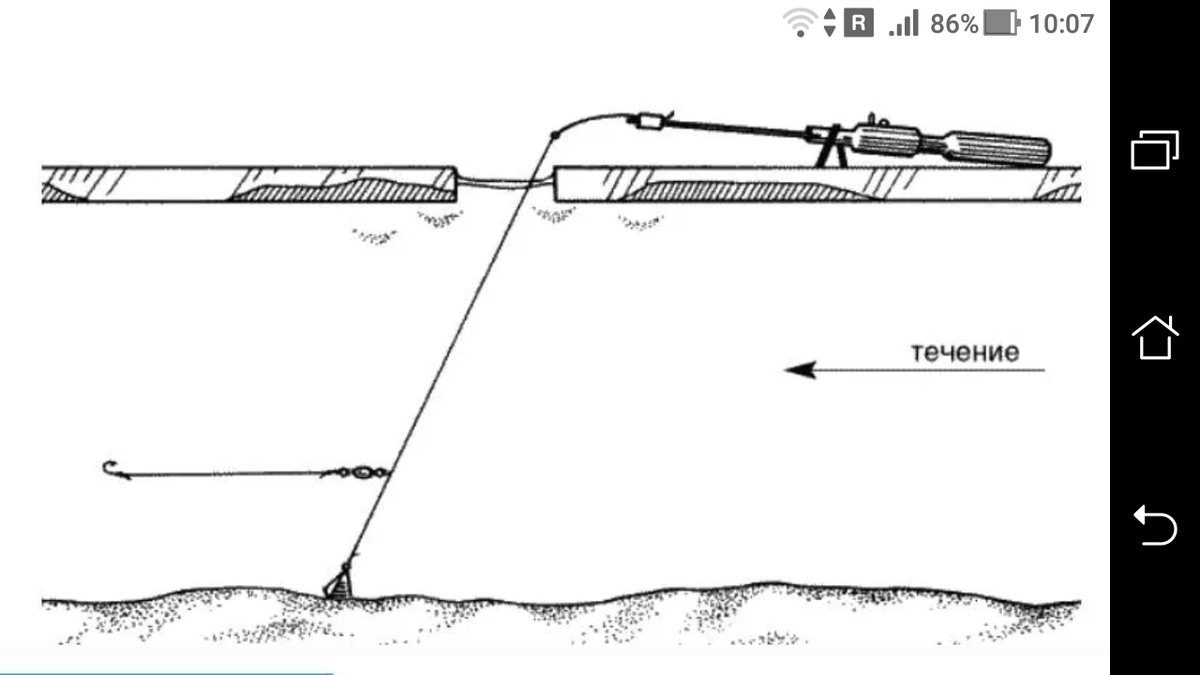
Winter bottom construction – accessories
The winter donk includes the following elements:
Alarm clock
Any winter fishing rod with a reel will do. Two requirements are imposed on it: it must be securely fixed on the ice, and it cannot be too light so that the fish does not drag it into the hole. The
Fishing line
The monofilament line is used. Its diameter depends on the size of the intended prey and on the weight of the lead used. The minimum thickness is 0.12 mm, the maximum (for a predator) is 0.40 mm.
Nod
The nod is used quite powerful, better made from a clock spring.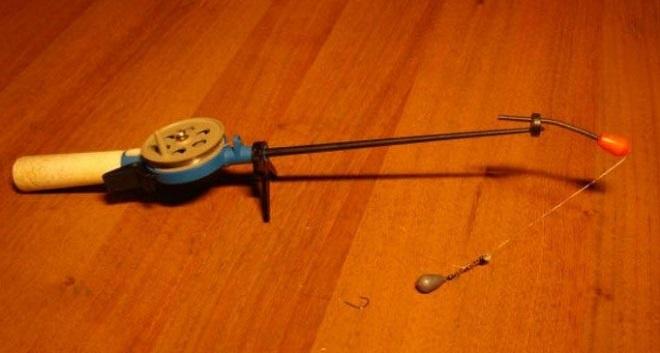
Rigging
There are two main options for rigs: with a lead attached to the end of the line and with a sliding lead. The first option assumes that a sinker or feeder is attached to the end of the line. It is better to fasten them through a swivel with a fastener so that the line does not twist and for the convenience of quick replacement of the sinker. Above the sinker, a swivel is attached.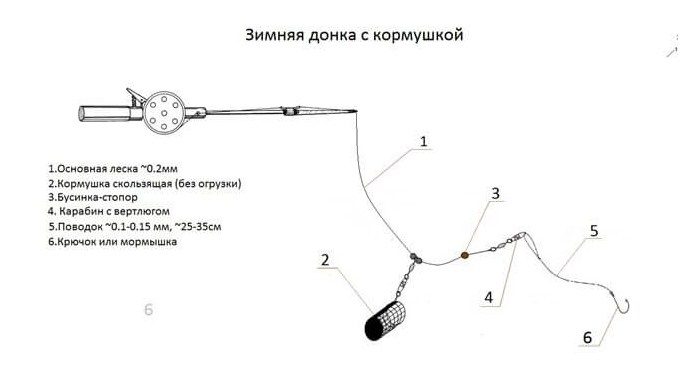
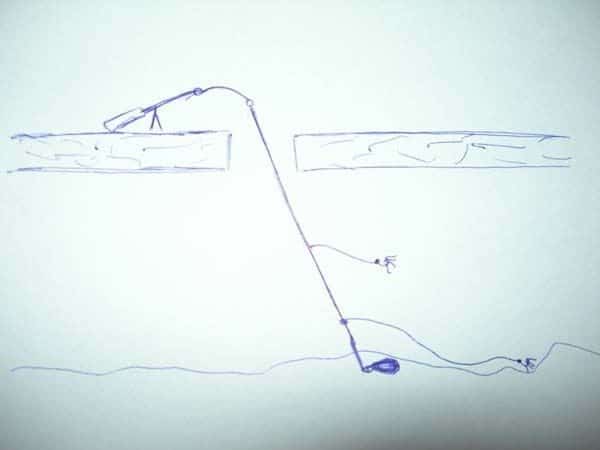

Important! The weight of the sinker (feeder) should be as small as possible so that the fish does not feel resistance when biting.
Next comes the fisherman’s fantasy. Some people make a sliding rig, but they tie another leash above the sinker, or even more than one. It turns out a “garland” rig, with the help of which different underwater horizons are caught.
Varieties of winter bottoms – installation and equipment options
Fishermen use several types of winter donuts. Sometimes this is due to the need to adapt to specific conditions, in other cases the main factors are the unwillingness to engage in active fishing or the desire to catch more fish.
Cargo – standard donk for ice fishing
Winter bottom, which uses a rig with a sliding sinker or feeder, a lower leash and an upper, mounted in a sliding version. The lower leash is designed for bottom fishing. The upper one can be set on any horizon and fish pelagic fish such as sabrefish or blue bream. On the top leash, several hooks or jigs are sometimes sequentially tied right on the fishing line. The result is a “steam locomotive” rig.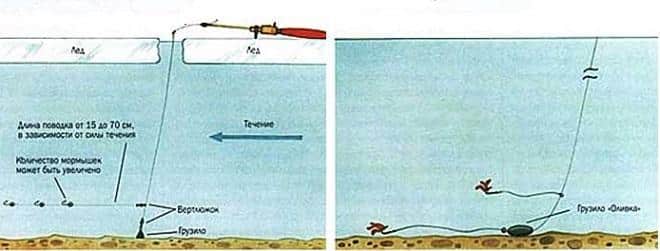
Donka without a fishing rod
On this tackle, the reel is mounted on a reel with a line, like a nod. Tackle for passive fishing.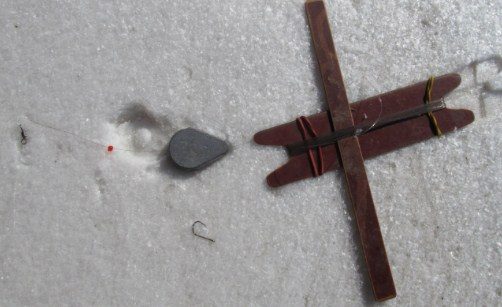
Donka caster
Improvisation on the theme of a winter trap for catching peaceful fish. The reel is attached to the board, the line is fixed in one way or another on the nod and, after a bite, begins to unwind. You can fish with several such tackles at once. Usually such tackle is used for catching large single fish, when quantity turns into quality, i.e. into a big catch.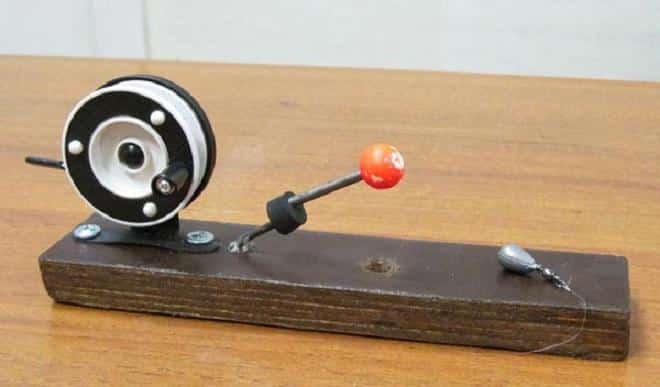
Winter feeder
For fishing, they use not a winter fishing rod, but a short spinning rod with a spinning reel. The rig is an ordinary truck. Fishing is carried out not with hands, but with a rod and a reel.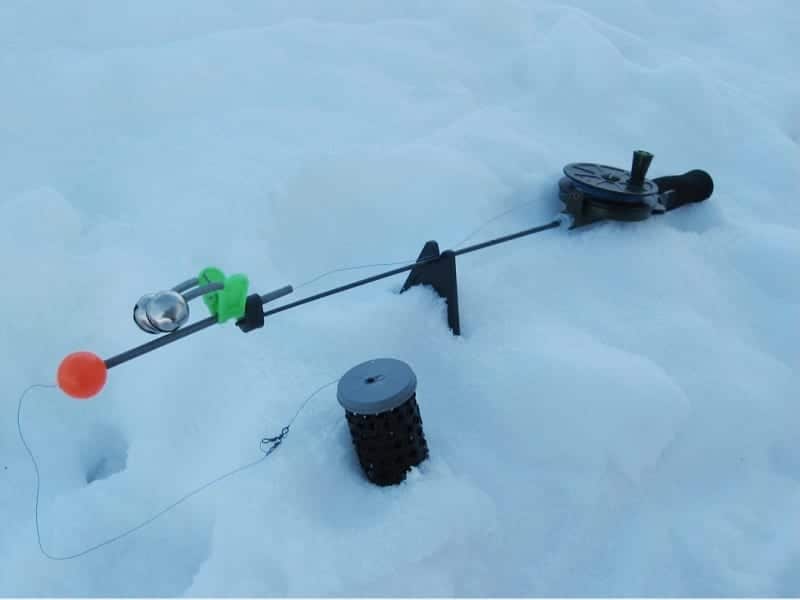
Tackle for pull-up fishing
The essence of this method is to gradually release the rig at a certain distance from the hole, and then slowly pull it back. Use a round slide lead and one bottom leader. Periodically twitching the fishing rod and releasing the fishing line, they ensure that the load moves to the desired distance, after which they begin the reverse wiring, making sure to pause. For such active fishing, a longer rod is required than for a stationary one.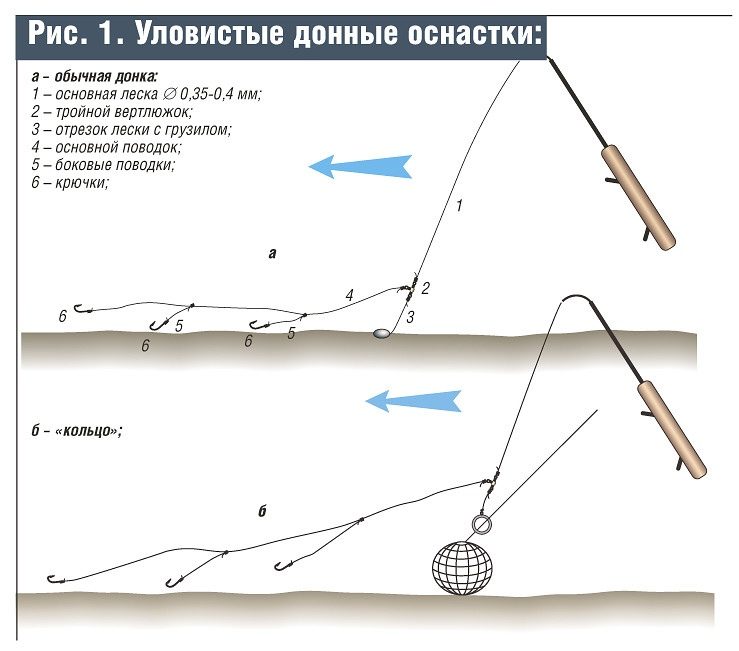
Donka descent
A special type of rig, on which it is not a leash with a hook that is sliding, but a retraction with a sinker. Thanks to this design, it is possible to change the fishing horizon during the fishing process. Several short branches of thinner monofilament with hooks or jigs are tied to the main line, which plays the role of a leash. Instead of a sinker, they usually use a feeder into which bloodworms or mormysh are stuffed.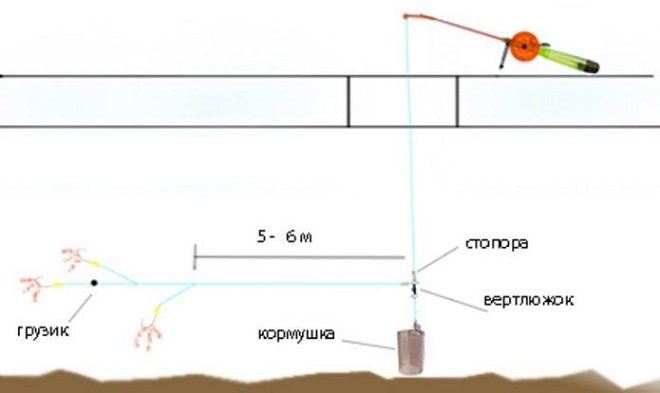
Donka helicopter (wing) – bottom tackle for fishing in winter
Special rig for deep water fishing. The sinker is tied tightly, and above it there is a sliding leash with several hooks, at the end of which there is a special device – a wing, which, due to the turbulence of the jet, moves in different directions, thereby increasing the attractiveness of baits and the likelihood of biting. However, if you lower the leash to the sinker itself, you can successfully catch bream.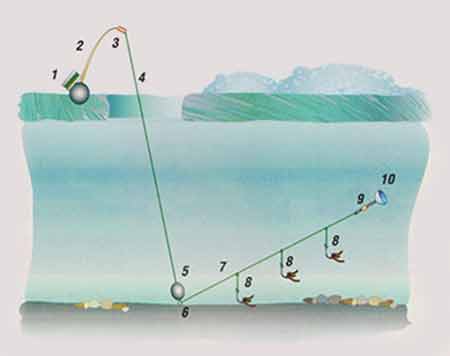
Donka rocker
A rocker arm is an additional piece of equipment, which is a piece of elastic wire with a central loop and two loops at the ends of the arms, to which the leashes are tied. The advantage of this device is that you can experiment with the bait by placing different types of bait on different hooks. It is also believed that when a fish sees two baits at the same time, this more provokes it to bite. The rocker arm, like a single leash, can be tied tightly or made sliding.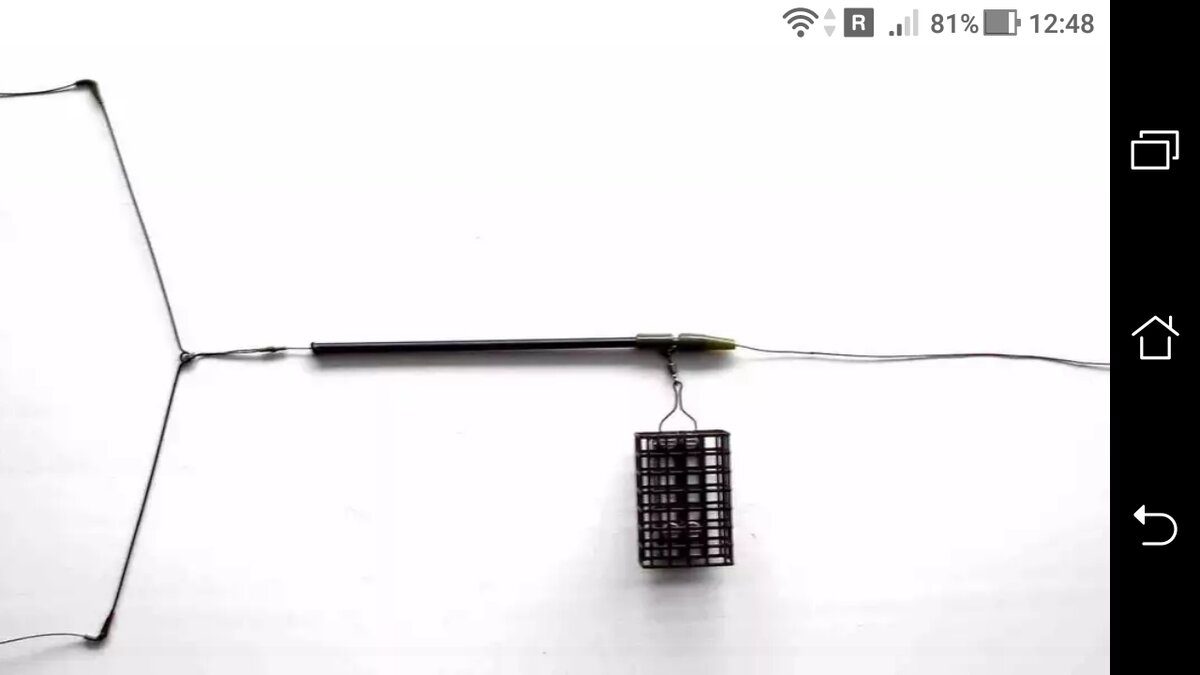
Winter donk for fishing in stagnant water
In stagnant reservoirs, you can also fish on a winter donk, but there are practically no special advantages over a conventional fishing rod with a jig. It must be understood that the hooks on the leashes will lie on the bottom, and not dangle in the stream, as when fishing on the current. However, if you feed the place well, then you can count on a significant catch, you just need to make both leashes short, so that one bait lies on the bottom not far from the load, and the second hangs in the water column above the sinker.
How to assemble a winter donka with your own hands
In principle, such tackles are always assembled by the angler himself, and if in the store you are offered to buy a ready-made winter donk, you should know that the seller assembled it, and from the cheapest components. The most common version of the winter donkey – the truck is assembled as follows:
- Fishing rods are wound on the reel of at least 30 meters of fishing line of the required diameter.
- They put a nod on the whip of the fishing rod and pass the line through it.
- Put a silicone stopper on the line.
- A swivel is mounted on the fishing line so that it glides freely along it.
- Put on the bottom stopper.
- The fishing line is passed through the through hole of the sliding sinker (feeder).
- Tie the swivel.
- Tie the leash to the upper swivel.
- The operation is repeated with the lower swivel.
- Leashes are equipped with hooks or jigs.
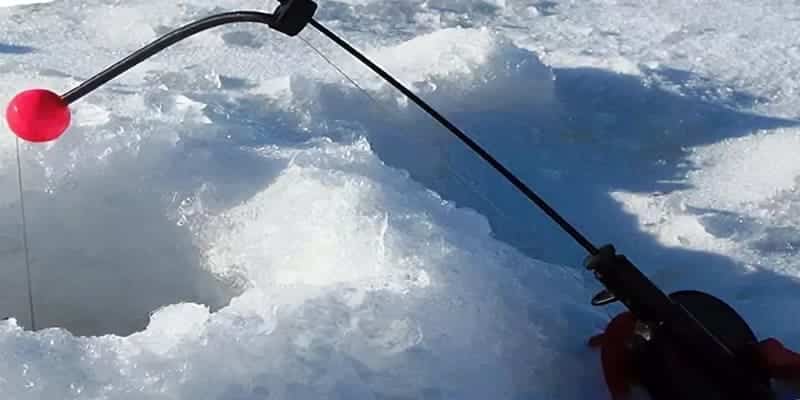
How to fish on a winter donkey: tactics, rules, secrets
The tactic of fishing on a winter donk is to find promising places. These are the following:
- exits from pits and entrances to them;
- channel dumps and curbs;
- any irregularities in the bottom relief.
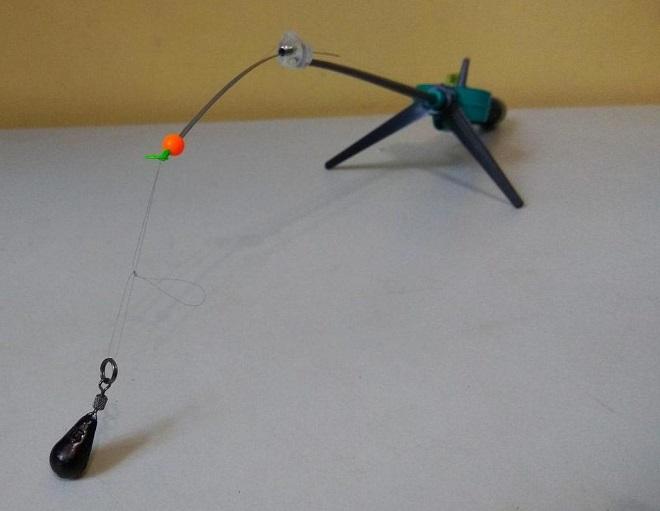
Attention! Winter bait should be low in calories and contain a minimum of flavorings. The amount of groundbait should be limited.
After that, you can start fishing. You will have to spend some time on each hole. First, you need to select the optimal weight. Secondly, determine the required length of the leashes. Thirdly, to fish not only the bottom layer, but also the water column. In the process of fishing, you should experiment with baits and baits.
Catching different types of fish on a winter donkey
On a winter donkey, you can catch any fish that lives in the reservoir, if you approach the matter responsibly.
How to catch roach on a winter donkey
The roach, as a rule, is kept away from the main stream, so the weight of the sliding weight does not exceed 4-6 grams. A traditional truck is used. It makes no sense to put a line that is too thin – during the course all the fish behave less carefully. The optimal leash length is 10-20 cm. You can use hooks or light metal jigs.
Healthy! The roach bite can be significantly improved if you fish with jigs with a light accumulator. At night this can be considered a prerequisite, but during daylight hours the roach reacts well to them.

Bream for bottom tackle
In catching bream, the main thing is to find a flock and keep it in place with bait. Bream can walk along the entire river – a strong current is not a hindrance for it. The tackle is selected according to the fishing conditions: on a small stream you can catch it with a truck, on a strong one – with a descent or a helicopter. Fishing for bream in winter on a donka harvester – video report: https://youtu.be/BfSRSeSpaAM
Carp
In the northern regions of Russia, crucian carp is inactive in winter, but in more southern regions it bites regularly all winter. On the course, the goldfish is caught with a truck. Complementary feeding plays an important role. Sometimes you have to wait several hours for the crucian carp to approach the bait, but then it will peck without ceasing. Therefore, it is useful to organize feeding tables, which will be fed regularly, even if fishing is not included in the plans.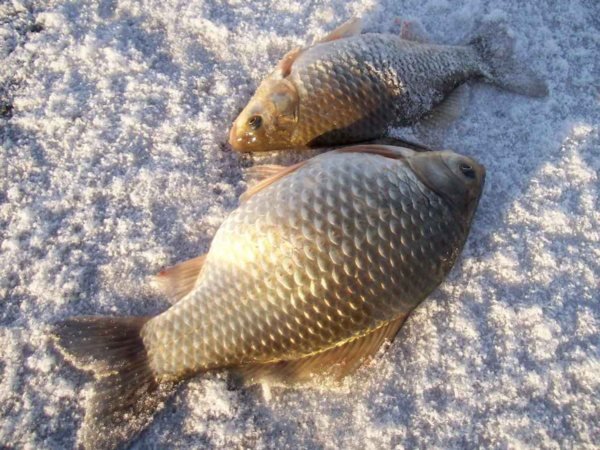
Ide
Ide is caught in the same way as roach, but the tackle, of course, must be more powerful. Of the baits, the ide prefers burdock and bark beetle, and in their absence, maggot.
Whitefish fishing
Whitefish are more often caught at depths of 4-5 meters, although sometimes they go out into shallow waters. Depending on the strength of the current, a type of winter bottom is selected. Whitefish responds well to bait, which is made by mixing fodder bloodworms with sand and clay. The groundbait balls should be washed out gradually. Mormysh works well as bait. When fishing for whitefish, you should fish all horizons up to the lower edge of the ice.
Burbot
Donka for burbot is a simple reel with a fishing line wound on it, to which a sinker and a hook are attached, and in any sequence. Donkeys are placed across the hole and checked periodically.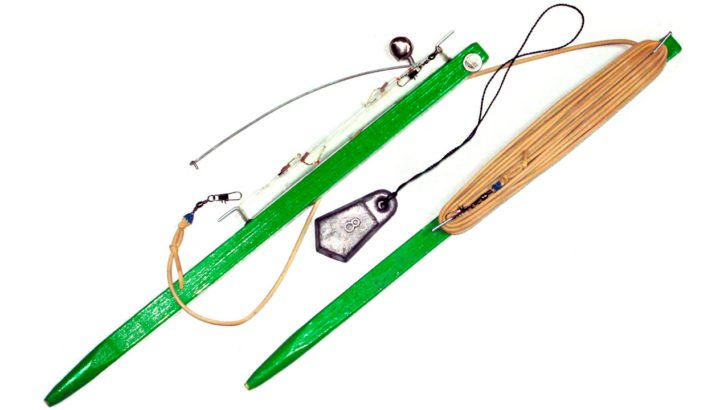
Perch
Fishing for perch with a winter bottom can be effective with the right choice of bait. If one trifle pecks at the bloodworms, then by placing the fry, it will be possible to catch the humpbacks.
Pike perch and bersh
Pike perch and bersh are caught on winter donks quite often. You can use both a tackle with one lower leash, and with an upper sliding one. As bait, small fish with a run-down body, tails or fillets of white fish cut into narrow strips are used.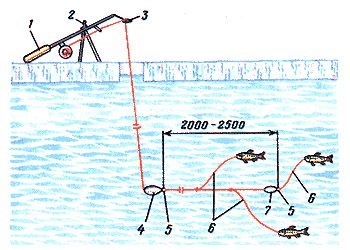
Pike
Pike is rarely caught on winter donkeys. If there is a likelihood of her biting while hunting for walleye, you should tie a metal or
fluorocarbon leash . Thus, we can come to the conclusion that when fishing in the current, a winter donk is often a more effective tackle than a fishing rod with a jig.
